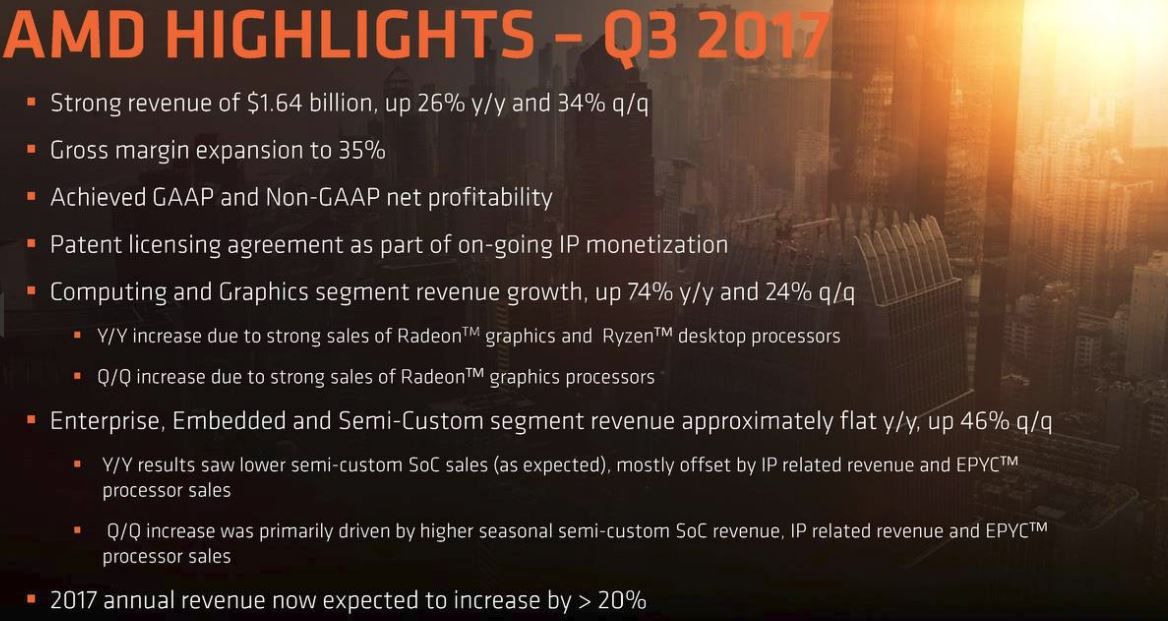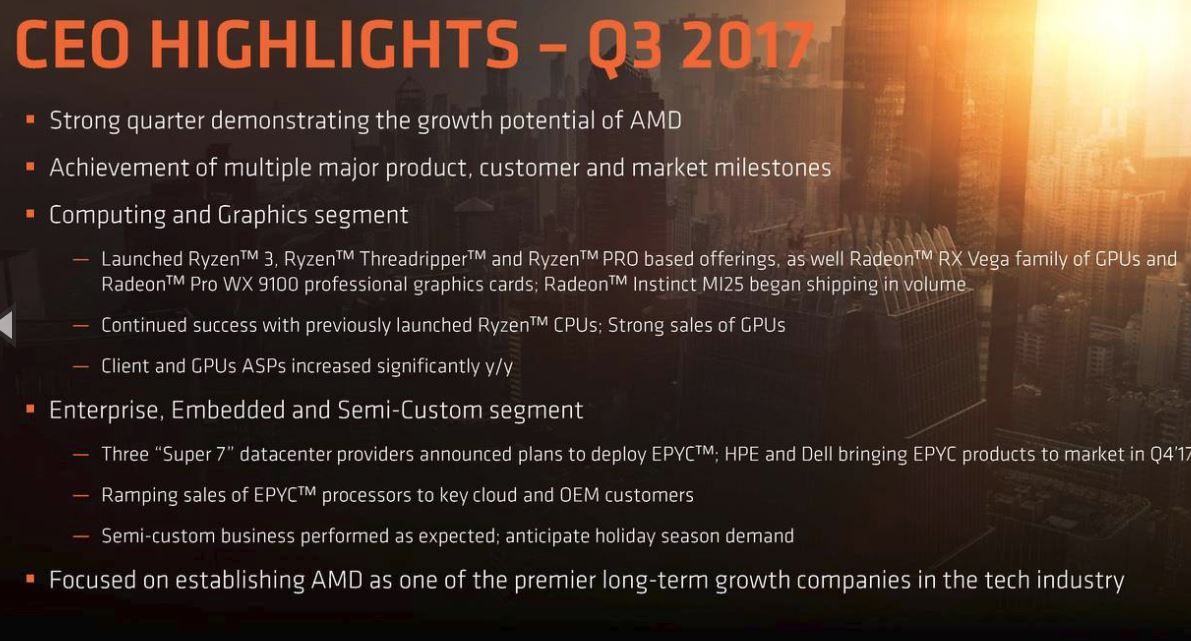AMD Posts Banner Q3 Financial Results; Returns To Profitability, But Stock Drops

AMD posted its first profit in three years during yesterday’s third quarter 2017 financial results. Highlights of AMD’s banner quarter include a $71 million GAAP profit, which comes largely due to a 74% increase in its Computing and Graphics segment to $819 million.
AMD doesn’t break out processor and graphics earnings separately, but the company said the increases mostly came from Ryzen and Radeon sales. AMD CEO Lisa Su noted that client computing revenue has increased by a “strong double-digit percentage” and that the company has reached 40% to 50% desktop processor share with some e-tailers.

AMD’s sales weighed in at $1.64 billion, beating estimates by $130 million. Revenue is up 26% year-over-year and 34% quarter-over-quarter, and the company expects to beat its previous yearly profit projections of “mid-to-high teens” percentage to 20%.
With all of these good vibes, we’d expect AMD’s stock to trade at record levels. However, AMD predicted that its sales would decrease 12 to 18% in the next quarter, which the company chalks up to seasonality (Q3 is always stronger than Q4) and the resulting slump in semi-custom revenue (primarily chips destined for game consoles).
As a result of the lowered expectations, AMD’s shares, which have jumped 115% this year alone, have dropped 13.5% at the time of writing.
Much of the investor angst stems from a Citi Research sell rating for AMD’s stock, and earlier this week the firm predicted that AMD’s shares would fall 60% due to Intel’s Coffee Lake processors. Obviously, the firm feels that AMD’s processors aren’t competitive enough against Intel’s latest.
But AMD has a 12nm LPP FinFET process shrink scheduled for next year, which could bring up to 10% performance improvement over the existing process. AMD confirmed that it would use the new process in both graphics and processors, so it will likely have a response ready for Intel’s Coffee Lake processors soon.
The signs of the company’s efforts made an appearance in AMD’s financials. The company has raised its R&D spend by 20% year-over-year. Su said the company intends to increase R&D spending linearly with revenue, so we might see a slight dip next quarter due to the reduced forecast.
A few other interesting tidbits popped up during the call, as well. AMD closed a patent licensing transaction that helped boost profit but didn’t provide further details. This transaction isn’t like the China-based Tianjin Haiguang Technology Investment Co. Ltd. (THATIC) agreement the company entered last year. AMD’s stock jumped over 300% last year following its announcement that it’s sharing CPU (including Zen) and SoC technology through its THATIC venture.
“So we did say that the IP transaction was a patent licensing related transaction. So that’s different from the technology licensing, for example, that we did with THATIC. This was a straight patent licensing. And the great thing about our patent portfolio is beyond sort of our core markets, it has applicability across a broad range of markets. And so this was a patent transaction and not a technology licensing transaction,” said Lisa Su (via Seeking Alpha).
Given the nature of the transaction, it’s doubtful this represents confirmation of the long-running rumor that Intel will incorporate AMD’s graphics technology.
AMD’s Wafer Supply Agreement is a key enabler for the company that guarantees enough wafers for production, but although AMD is committed to the Global Foundries relationship, it isn’t exclusive. AMD has options to procure wafers from other fabs if needed. As we reported last year, AMD has to essentially pay a fine to Global Foundries if it sources from other fabs. That came into play as well.
“Gross margin was 35%, up 4 percentage points year-over-year, primarily driven by the benefit of IP-related revenue and a richer mix from the Computing and Graphics segment, which were partially offset by costs associated with our global foundries wafer supply agreement for wafers purchased at another foundry,” said Davinder Kumar (via Seeking Alpha).
AMD didn’t disclose the mystery fab, but it is widely believed to be TSMC. It also isn’t clear if the wafers are destined for Ryzen processors, which might be due to a surge in demand.
AMD is also furthering its EPYC data center initiative, but that long-term investment will take time to come to fruition. AMD has several wins with major hyperscalers, such as Baidu, Tencent, and Microsoft Azure. HP Enterprise and Dell also have plans to deploy their first market-ready platforms in Q4, which should boost EPYC’s market penetration.

Overall, AMD has a solid future roadmap. The company continues to significantly benefit from the advent of blockchain (mining) on the graphics side, but the investing community is clearly skittish about the threat from Intel’s revamped processors. Given that Intel’s Coffee Lake processors are almost impossible to purchase, that might not be as much of a threat in the next few months. But there will be a pitched battle for desktop sockets as we move into next year.